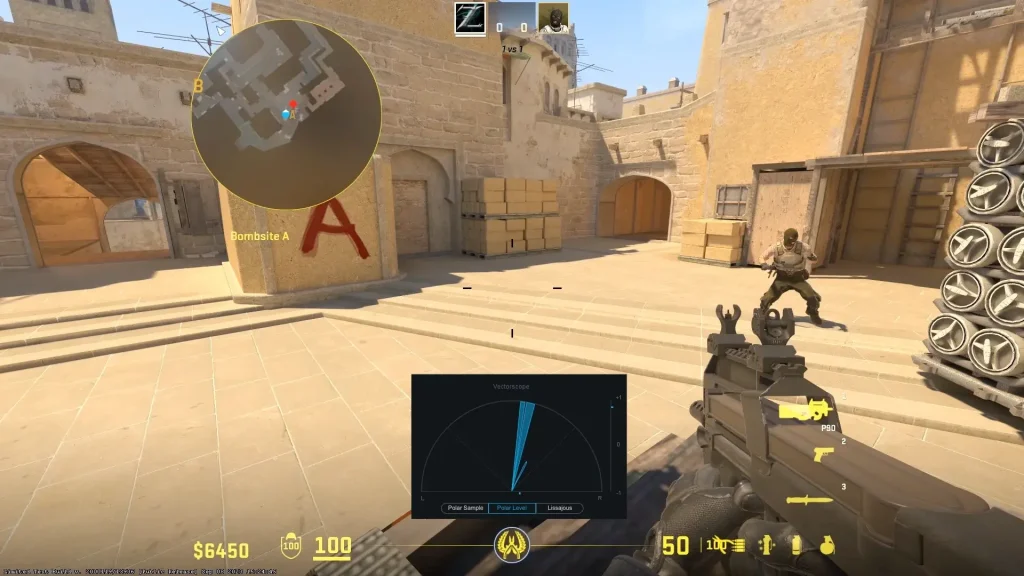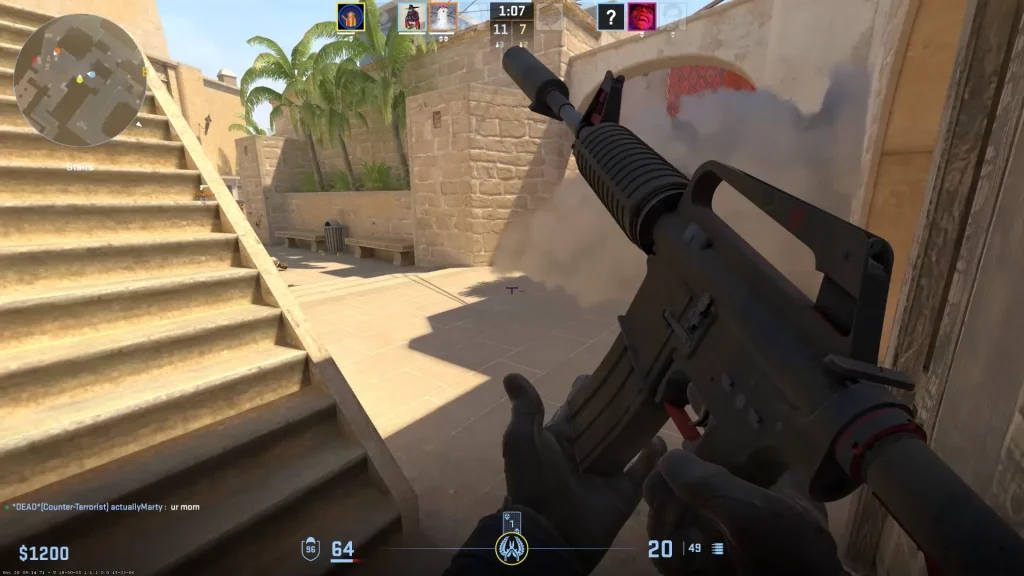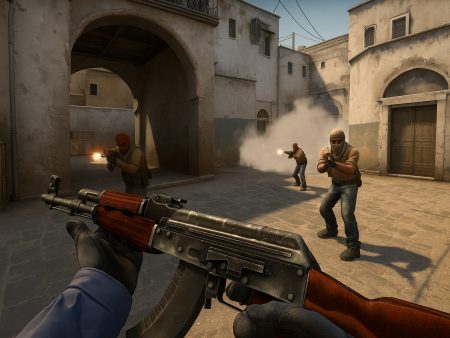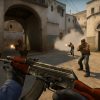Master the art of sound in CS2 with this in-depth guide to footsteps, audio cues, and sound strategy. Learn pro tips, audio settings, and how to use sound for a competitive edge.
In the competitive world of Counter-Strike 2 (CS2), split-second decisions separate the victors from the vanquished. And while your aim, reflexes, and strategy are all important, there’s a silent hero that often goes unnoticed—sound. Whether it’s the sharp echo of footsteps approaching from long A or the telltale click of a bomb being planted, understanding audio in CS2 can turn an average player into a clutch master. In this guide, we’ll explore how CS2’s sound system works, how footsteps and audio cues play into gameplay, and how you can sharpen your hearing for that competitive edge.
Introduction to Audio in CS2
Why Sound Matters More Than Ever

Let’s be honest: if you’re playing CS2 without seriously considering how you’re hearing the game, you’re playing with a massive handicap. Audio cues give you intel before you even see your enemies. Whether it’s footsteps from an enemy rotating, the pin being pulled on a grenade, or even a faint jump on a box—these sounds can and should influence your next move. The new audio system in CS2 amplifies the importance of listening, transforming every subtle sound into a tactical asset. In a game where peeking a corner a second too late means death, sound is your sixth sense.
What makes CS2 different is how well audio is integrated into the gameplay loop. You can hear if someone is full sprinting versus walking, jumping versus landing, or switching weapons mid-peek. And in clutch situations, it’s not your crosshair but your ears that might save you.
The advantage goes beyond survival—it influences your playstyle. Aggressive players use audio to pressure opponents, while defensive players use it to trap and bait. Without sound, you lose access to this rich layer of information. So if you’re just starting out or trying to rank up, understanding how CS2 handles sound is one of the smartest things you can do.
Evolution of Audio from CS:GO to CS2
CS:GO had good sound, no doubt about it—but CS2 brings it to a whole new level. The transition from the Source engine to Source 2 brought several technical upgrades, and audio was a big part of that. In CS:GO, sound propagation was often limited by map geometry and prone to bugs. Footsteps could sometimes be unreliable due to old sound mixing methods. But CS2 changes all that with more accurate, consistent, and immersive audio behavior.
The new engine features high dynamic range (HDR) audio, better occlusion (how sound is blocked by objects), and real-time echo simulation based on map environments. In simple terms? You can now hear how far away something is, whether it’s coming from inside a hallway or from behind a wall—and it actually makes sense. For example, in Inferno, footsteps on Banana echo differently than in Apartments, and this can clue you in on enemy positions more precisely.
Also, the revamped mix means things like footstep clarity, grenade bounces, or even reload clicks now stand out in the heat of battle. CS2 doesn’t just sound better—it sounds smarter. And this realism forces players to be more disciplined in how they move and act in the game.
The Science of Sound in CS2
What Makes CS2’s Audio System Unique
CS2’s sound design goes beyond aesthetics—it’s deeply tied into how the game is played. Thanks to the Source 2 engine, sound propagation behaves more like it would in real life. Sound travels through open spaces, bounces off surfaces, and gets muffled or redirected based on what’s in the way. This means you’re not just hearing sounds—you’re also hearing the environment shape those sounds.
This system gives players the ability to do advanced sound tracking. For instance, if you hear two quick footsteps followed by silence, it might mean the enemy started sprinting and then switched to walking to avoid detection. The game even simulates how a sound bounces, so you can often tell if it’s coming from above, below, or through a corridor. It adds a 3D layer to the battlefield that rewards players who train their ears.
CS2 also does a fantastic job differentiating between sound types. Reloading has a different audio signature than pulling out a knife. The bounce of a smoke grenade versus a flashbang is subtly distinct. It’s like a language—and the better you understand it, the more fluent you become in reading the battlefield through sound alone.
How the Source 2 Engine Enhances Audio Fidelity
When Valve decided to port CS2 into the Source 2 engine, one of the major upgrades was in sound fidelity. The audio engine now supports more complex soundscapes, more spatial accuracy, and more responsive mixing. That means when an event happens—whether it’s a gun firing, a footstep landing, or an object falling—the sound you hear is more immediate, more precise, and more detailed than ever before.
Source 2’s engine also allows for positional audio with better granularity. For players using stereo or surround sound setups, you can actually pinpoint an enemy’s direction to within a few degrees. You’ll hear if they’re slightly to your left rather than directly in front, which is a huge deal in close encounters.
Another perk is how the engine handles dynamic range. Loud sounds like an AWP shot are thunderous, while quieter cues like a scoped weapon toggle still get their own space in the mix. This layering makes it easier to isolate important sounds even during a chaotic firefight. You’ll never again confuse an ally’s reload with an enemy’s approach—if you’re listening carefully.
Footstep Mechanics in CS2

Sound Radius and Distance Awareness
Footsteps in CS2 aren’t just sound effects—they’re tactical breadcrumbs. Every time you move, you emit sound waves that can be heard by nearby enemies, depending on your movement type and proximity. These sounds follow a radius model. For instance, running can be heard from a much greater distance than walking or crouching. But here’s where it gets interesting: CS2 now factors in materials, obstacles, and elevation, giving footsteps a more accurate 3D projection.
So when you’re sprinting down Mid, that thump-thump of your boots will echo and alert everyone within range. But if you’re walking, the sound radius drastically shrinks. It’s not silent, but it’s close enough to give you stealth if the enemy is distracted or not wearing headphones.
This audio model also encourages strategic movement. Want to bait someone? Fake a rush with heavy footsteps and then pull back. Need to sneak behind enemy lines? Walk or crouch to stay under their radar. Understanding how far your sound travels—and what surfaces you’re moving on—can make the difference between life and death.
Differentiating Between Teammates and Enemies
One of the most confusing things for newer players is identifying who’s making noise—your teammates or your enemies? In CS2, Valve addressed this by tweaking the volume and spatial presentation of team-related sounds. Generally, teammate footsteps are slightly quieter and come from a less directional source, especially in stereo setups.
However, in high-pressure moments, this distinction can still blur. That’s why experienced players often rely on communication: calling out when they’re moving, peeking, or rotating. But even without comms, you can learn to “tune out” your team’s audio footprint. Their patterns are usually predictable—enemy footsteps are more erratic, sneaky, or panicked.
You’ll also notice differences in weapon handling. If your teammate is on the A site and you hear a reload from Catwalk, chances are it’s not your guy. Learning these audio “tells” becomes a kind of sixth sense. And the more you play, the more your brain will start sorting friend from foe by instinct.
Impact of Movement Type (Walking, Running, Jumping, etc.)
Every movement type in CS2 has a unique audio footprint. Running makes you the loudest. Jumping adds an audible landing thud. Walking dampens your steps, and crouching? That’s the ninja move—practically silent unless you bump something. Players need to master these differences to control the noise they make.
Jump-peeking a corner? Your feet will give it away. Holding W into a site? They’ll hear you before they see you. But if you mix in slow walking or crouch-walking, you can sneak up on distracted enemies with surprising ease.
What’s more, movement noise varies by surface. A wooden floor makes a different sound than concrete or metal. Smart players use this to recognize where someone is, even if they can’t see them. Hear footsteps on wood? They’re likely in Palace. Hear a clang? Maybe they’re walking on Heaven.
The bottom line: every movement is a choice between speed and stealth. Mastering the sounds they create is how you stay one step ahead in CS2.
Audio Cues That Can Change the Game
Reloading, Weapon Switches, and Utility Sounds
Every sound in CS2 carries weight—especially those that happen in the thick of combat. Reloading a weapon, switching between guns, or even pulling the pin on a grenade can expose your position to alert ears. If you’re within earshot of an enemy and decide to reload without cover or proper timing, you’re practically inviting them to peek and punish you.
Reloading is one of the most revealing audio cues. Each weapon has a distinct reload sound, and experienced players can identify the weapon just by that. If you hear a long reload with a metallic snap, you might be dealing with an AWP. A faster, click-heavy reload? Probably a rifle like the M4 or AK. This kind of info is golden—it tells you not only that someone is close but also what kind of threat you’re about to face.
Weapon switching is another critical cue. Switching from a primary weapon to a pistol or knife makes a subtle but noticeable sound. If you’re close enough, this can signal that the enemy might be out of bullets or about to knife-rush. Many pros fake weapon switches to bait peeks—it’s a subtle mind game that rewards attentive listeners.
Utility usage is perhaps the loudest and most telegraphed sound cue. The sound of a grenade pin being pulled, the “tick” of a molotov igniting, or the bounce of a flashbang can all signal intent. Want to fake a site take? Throw a flash. Need to scare off a CT on B? Bounce a smoke or molly into the site. It’s not about throwing—it’s about being heard throwing.
When used intentionally, these sounds can manipulate enemy behavior. Fake a reload to bait a push. Pull out a grenade to suggest aggression, then back off. Sound isn’t just for reacting—it’s also for crafting traps.
Environmental Sounds and Map-Specific Cues
One of the more overlooked elements of CS2’s soundscape is the environment itself. Every map in CS2 has its own acoustic fingerprint. From the tight corridors of Nuke’s B site to the open arches of Mirage Mid, the environment shapes how sound travels—and how you should react to it.
Take Inferno, for example. If someone runs down Banana, the sound echoes because of the long stone walls. This makes it easier to detect rushes even from Top Mid or CT. Meanwhile, in Vertigo, the metal grates make footsteps louder and more distinguishable. If someone is sneaking through B stairs, a trained ear can hear them well before they peek.
There’s also verticality to consider. In Overpass, for instance, players often use sound from below (like Connector) to guess enemy movement above. The maps are designed to enhance tactical audio play. Knowing which areas are “louder” or more acoustically open can help you decide whether to run or sneak.
Even static environmental noises—like the burning sound of molotovs or the “hum” near bomb sites—add to the complexity. You need to filter those out while focusing on player-generated sounds. This is why map-specific audio familiarity is crucial. Play the same map enough, and you’ll start predicting movement just by how the sounds differ from the ambient norm.
Using Audio to Predict Enemy Behavior
Pro players often seem psychic, like they know what the enemy will do before it happens. The truth? They’re listening—really listening. Audio cues give away so much information that, when interpreted correctly, allow players to predict rotations, flanks, and site hits before they happen.
Let’s say you hear one flash thrown from A Long on Dust 2, followed by fast footsteps. You can safely assume it’s not a solo player—teams usually flash for each other. Expect multiple enemies. Or, if you hear running into Apartments on Mirage but no follow-up sounds, it could be a fake to draw a rotation. This is high-level play built entirely on sound interpretation.
Another example: you hear a quick peek followed by silence. This might mean the enemy spotted someone and is now repositioning for a repeat peek or waiting for support. Every pause, burst of noise, or even awkward movement tells a story. Your job? Be the narrator. Read between the lines and act accordingly.
In solo queue, players who master this skill dominate. You can flank when others are frozen in fear. You can rotate early while your teammates delay. And you can save more often because you knew it was a 1v4 before anyone else did. Sound is your radar—tune in, and the game will speak volumes.
Positioning and Audio Advantage
How to Use Sound for Pre-Aiming and Pre-Firing
Ever seen someone pre-aim perfectly and wondered how they knew? Often, it’s not wallhacks or ESP—it’s just great audio processing. In CS2, smart players use sound to narrow down enemy positions, giving them the edge in both reaction time and aim placement.
Footsteps give away not just position but direction and speed. Hear someone sprinting towards a corner? You can pre-aim head height and be ready to click as soon as they peek. If the sound is slower or intermittent, they might be walking or checking angles, which means your timing has to be tighter.
Combine this with map knowledge, and you become deadly. Let’s say on Mirage, you hear a footstep in Apps, followed by a jump sound. They’re probably lining up a window smoke or making a jump to bench. That gives you precious seconds to aim or reposition. It’s not magic—it’s just using what the game is telling you.
Sound also lets you prepare utility. Hear someone pushing short? You can throw a pop flash around the corner before they appear. This preemptive use of sound turns defense into offense, letting you control the pace of the engagement.
Holding Angles Based on Sound Info

There’s holding angles—and then there’s holding them intelligently. CS2 rewards players who adjust their angle-holding based on the soundscape around them. If you know an enemy is about to peek, you don’t have to jiggle or risk giving away your position. You just sit and wait, crosshair in the perfect spot, listening for that final footstep before the peek.
This is especially effective when you’re holding a tight angle like Connector on Mirage or Banana on Inferno. If you hear running, you can hold a wide angle for a rush. If it’s just slow walking, you hold tighter or prefire off timing. The sound gives you the “why” behind every “where” and “how” of angle holding.
Another tactic is to let them make noise before acting. Hear them run through Monster on Overpass? Wait for the second guy before spraying. Sound gives you a tempo—a rhythm—and once you learn it, you’ll start syncing your plays to that rhythm. Like a jazz musician hitting the perfect note on a downbeat, you’ll know exactly when to strike.
Rotating and Flanking With Stealth
Silent movement is an art. In CS2, rotating and flanking without being heard is often more valuable than raw aim. If you can sneak behind a distracted enemy team during their site execute, you’re practically guaranteed multi-kills. But to do this, you need to master movement and sound suppression.
First, always walk or crouch when close to enemies. Don’t rush unless you’re absolutely sure they can’t hear you. Second, use the map’s geometry to mask your sounds—run when near noisy areas like bomb beeps, gunfights, or grenades going off.
Third, be unpredictable. If you flank the same way every round, good enemies will pre-aim or hold for it. Change your timings, vary your speeds, and use sound against them. Fake a flank with loud steps, then double back. Or start running to suggest a rotate and stop just before they hear you.
Good flanks win rounds. But great flanks? They demoralize enemies. When you appear behind them like a ghost and clean up with ease, it’s not just a kill—it’s a psychological win. And all of it comes down to how well you control your sound.
Headphones vs. Speakers: The Competitive Edge
Stereo vs. Surround Sound in CS2
If you’re serious about CS2, one of the first upgrades you should make isn’t your GPU or your monitor—it’s your headset. The difference between stereo and surround sound setups can completely transform how you play. CS2’s sound design thrives on directional accuracy, and your audio gear determines how well you can pick up on those critical cues.
Stereo sound, when paired with good virtual surround software or settings, is still the go-to for most pro players. It offers clear left-right balance and can be surprisingly accurate when configured properly. With the right audio positioning, you’ll know whether the enemy is coming from short, long, or stairs—and react accordingly.
True surround sound setups, such as 5.1 or 7.1, can sometimes muddy the clarity due to excessive sound channels. Many pro players disable full surround and instead rely on virtual surround processing like Dolby Atmos, DTS Headphone:X, or Windows Sonic. These simulate 3D audio through stereo headsets and are often more reliable for pinpointing in-game noise direction.
Ultimately, it’s less about how fancy your headset is and more about how well you’ve tuned it. Proper EQ settings, surround simulation, and understanding how sound is represented spatially in CS2 will give you the advantage. Whether you’re in a 1v1 clutch or defending a site solo, hearing an enemy half a second earlier can make all the difference.
Best Audio Settings for Optimal Footstep Detection
Let’s get practical. All the fancy gear in the world won’t help if your in-game settings aren’t optimized. CS2 offers several key audio options that you need to configure for footstep clarity and tactical listening.
Here’s a quick table of recommended settings:
| Setting | Recommendation |
|---|---|
| Master Volume | 100% (adjust system volume instead) |
| Audio Device | Direct output to headphones (no enhancements) |
| Spatial Audio | On (use Windows Sonic or Dolby Atmos) |
| L/R Balance | Centered (adjust if you have hearing imbalance) |
| EQ / Bass Reduction | Reduce bass, boost mids and highs |
| Music Volume | 0% (especially round start/end music) |
| Voice Chat Volume | 50–70% (low enough to hear footsteps) |
Your goal with these settings is to maximize clarity. Footsteps and utility noises exist in the mid to high frequency range, so you want those frequencies to be loud and crisp. Too much bass muddies the mix, and background music just clutters the auditory field.
One often overlooked tip: disable unnecessary apps like Discord’s noise cancellation or Windows enhancements. These can suppress soft game audio or distort spatial cues. Keep your audio chain clean and direct from the game to your ears.
Map Awareness Through Audio
Recognizing Sounds Unique to Specific Locations
Every map in CS2 has its own audio “language.” The more you play, the more you’ll realize how much you can deduce just by where the sound is coming from. Is that a wooden creak from Mirage’s Apartments? A metallic clang from Nuke’s catwalk? Recognizing these subtle environmental sounds helps you position preemptively and take control.
On Inferno, for example, footsteps in second mid sound hollow and far-off, but once they step into apartments, they sharpen and echo differently. This change in tone is your signal to get ready. On Overpass, jumping into water has a very distinct splash that echoes in construction—perfect for catching B pushes early.
Train your ear to connect sounds with locations. It’s not just about knowing “I hear footsteps,” but rather “I hear footsteps on scaffolding above B site,” which tells you exactly where they are and what they might do next.
Learning Audio Tells for Each Map
Every CS2 map has choke points, rotation paths, and setup positions where sound plays a huge role. You need to develop what we call audio muscle memory—the ability to instantly recognize a sound and pair it with an exact location and possible strategy.
Here are a few examples:
- Dust2: The sound of jumping onto Xbox tells you someone’s trying to push Mid to Cat.
- Ancient: Walking on the stone tiles has a unique echo—knowing when you hear it means someone’s either near Cave or Donut.
- Mirage: You can tell the difference between movement in B Apartments and movement in Underpass by the sound of steps on the different surfaces.
Start by picking your favorite map and spending time just listening. Play deathmatch or casual with headphones and focus purely on audio recognition. The better you get at connecting sounds with specific spots, the faster and more confidently you’ll react in matches.
Communication and Audio Synchronization
Balancing Voice Chat With In-Game Sounds
We’ve all been there: you’re trying to hear an enemy creeping up behind you, and your teammate is yelling “Nice shot!” over comms. Managing voice chat noise is one of the trickiest parts of competitive CS2.
Voice chat is critical—but if not managed properly, it can drown out crucial in-game sounds. That’s why pros keep their voice volume low and enforce tight comms discipline: short, clear, and only essential calls. If someone’s mic is constantly open or too loud, they’re sabotaging your game sense.
Use the in-game audio mixer to reduce voice chat volume to a level that doesn’t overpower footsteps or reloading cues. Better yet, train your team to communicate by timing, not over-talking. Quick phrases like “One apps,” “Flashed A,” or “Rotating B” work better than drawn-out commentary.
If you’re solo queuing, don’t be afraid to mute a teammate who’s being disruptive. You’ll win more games when you can focus on what the game is telling you, not what some stranger is yelling.
How Teams Use Sound for Tactical Execution
Pro teams use audio like a conductor uses a baton—it orchestrates everything. From synchronized utility throws to perfectly timed pushes, every move is either triggered by or disguised using sound. Teamplay at the highest level includes calling out enemy audio cues, syncing footsteps during silent takes, and using utility sounds to bait reactions.
A perfect B take on Inferno might involve one player making noise on Banana while three teammates silently creep through CT smoke. Or a team might flash mid and fire one shot, just to make the CTs rotate, then fall back into an A hit. These plays rely heavily on manipulating what the enemy hears.
The best teams don’t just use voice for calls—they use it to coordinate audio strategy. “Fake footsteps now,” or “Stop moving, listen,” are common phrases in their comms. If you’re playing with a regular squad, consider designating someone to listen for info and call plays based on what they hear. It’s like having an audio analyst in your pocket.
Common Mistakes Players Make with Sound
Overcommitting Based on Misheard Audio
Relying on sound can be a blessing—but it can also be your downfall if you misinterpret what you hear. One of the most common errors in CS2 is overcommitting based on a single audio cue. You hear a step, assume it’s a full rush, rotate too early, and abandon your site—only to realize it was just one player faking movement.
This kind of hasty reaction happens all the time. Players often panic when they hear fast footsteps, mistaking it for an entire team. The problem isn’t the sound—it’s the interpretation. Smart players wait for confirmation: more steps, utility being thrown, or comms from a teammate. Sound should guide your decisions, not dictate them blindly.
Another common mistake is rotating without confirming audio source direction. Sometimes, you might hear noise from A but it’s echoing from Mid or Lower Tunnels. This is where headphones and proper audio settings make a huge difference. Don’t act unless you’re confident—guesswork can lose rounds.
Remember: the best players don’t react to the first thing they hear. They wait, listen, and confirm. It’s not just hearing—it’s understanding what the game is trying to tell you.
Ignoring Soft Audio Cues Under Pressure
In the heat of battle, it’s easy to focus only on the loud stuff—gunshots, flashes, bomb beeps. But in CS2, it’s often the quietest sounds that matter most. A faint reload, a slight jump noise, a scoped rifle unscoping—these are the cues that win clutches.
Many players train their aim but not their ears. Under pressure, their brains filter out soft sounds, prioritizing the visual chaos. But those little cues are often all you have in a 1v2 or 1v3. Learn to listen through the chaos. Stay calm, block out the noise, and tune in to what matters.
A scoped weapon like the AWP or SCAR-20 makes a distinctive unscoping noise when the player releases zoom. If you hear it, that’s your chance to peek. The same goes for half-reloads or utility drops. Players who panic during these quiet actions make noise—and smart opponents pounce.
So train yourself to hear everything. Even in the loudest rounds, those soft cues can give you the timing or location you need to pull off something incredible.
Training Your Ear for Competitive Play
Exercises to Improve Audio Recognition
You can train your aim, your smokes, your recoil control—but how about your ears? Improving your audio recognition is one of the most overlooked parts of CS2 training. And yet, it’s critical if you want to play at a higher level.
Start with custom games. Load into a private server with bots and set them to run around maps while you stand still. Try to guess their location based solely on footsteps. Adjust your position, close your eyes, and test yourself. It may sound silly—but it works.
Next, rewatch demos with sound-only focus. Mute the caster audio and just listen to what’s happening. Try to anticipate moves based on footsteps or utility sounds. You’ll start picking up subtle cues you never noticed before.
Another tip: turn off music while playing. Train your brain to prioritize in-game audio over distractions. And don’t just rely on visuals. Listen for reloads, footsteps, pin pulls, and learn to act without always needing visual confirmation.
Your ear is a weapon. Train it like you do your crosshair, and your overall game awareness will level up dramatically.
Watching Pro Plays With a Focus on Sound
Pro matches are goldmines for audio training—but you need to watch them with the right mindset. Instead of just admiring the clutches and flicks, focus on what they hear. Watch how a pro rotates based on a single footstep. Notice how they delay peeks until after a reload. Pay attention to their reactions to sound cues, and you’ll realize they rely on audio more than anything else.
Some streamers even provide POVs where you can hear their game audio clearly. Use those to study how they communicate and respond to subtle cues. You’ll see that many plays are based on intuition built from sound recognition, not just map knowledge.
And when you play, try to replicate that discipline. Instead of rushing, take a second to listen. Instead of peeking blind, bait out a sound first. The pros aren’t magic—they just listen better than most players.
Pro Tips for Mastering Audio in CS2
How Top Players Exploit Audio Cues
The best CS2 players don’t just react to sound—they weaponize it. They create pressure through footsteps, fake noise to bait rotations, and exploit every audible action. One of the most common pro tactics? The “step fake.” You take one or two loud steps, then immediately go silent. The enemy hears it, assumes a push, and adjusts their aim—leaving them vulnerable to a delayed peek or rotation.
Another trick is syncing with utility noise. For example, you throw a flash over a wall, and while it pops, you sprint into a new angle. The flash masks your steps, giving you a stealth advantage without walking. Pro players also listen for reloads to time re-peeks. If they hear a half-reload? Boom—instant swing.
Smart players don’t waste sound. They use it deliberately—either to mislead or to confirm. And they never overstep unless it’s part of the plan. If you want to play like the pros, you have to think of sound not just as a mechanic—but as a strategy.
Learning Sound Traps and Baits
Sound traps are sneaky, underused tactics in CS2. They involve manipulating sound to force mistakes. For example, tapping the bomb once and then hiding triggers the enemy to peek, thinking you’re sticking the defuse. Or pretending to walk away, only to return silently for a surprise engagement.
Another effective sound bait is weapon drops. Drop your primary to make it sound like you’re rotating or switching guns. Enemies might assume you’re low on ammo or distracted—and peek into your trap. Even walking back and forth across a metal surface can create confusion, making enemies misjudge your actual location.
Baiting with sound requires discipline and timing. You have to be calm enough to let the enemy make the first move. But once you master it, you’ll control the battlefield without firing a shot. It’s Jedi-level stuff—and it wins games.
CS2 Sound Settings Explained
What Each Setting Does and Why It Matters
Understanding CS2’s sound settings is key to hearing things clearly and reacting fast. Here’s a breakdown of what each setting does—and what you should change:
- Master Volume – Controls all game sounds. Keep at 100% and adjust system volume instead.
- Audio Output Configuration – Choose “Stereo Headphones” or your actual audio setup. Avoid “Speakers” unless you’re playing casually.
- Enable HRTF – This is Valve’s 3D audio simulation. TURN THIS ON. It significantly improves positional awareness.
- Spatial Audio – Optional Windows setting (like Sonic or Dolby). Works well with HRTF for enhanced surround effect.
- L/R Balance – Keep centered unless you have hearing differences.
- VOIP Volume – Lower it to keep comms from overpowering game sounds.
- Music – Set all music (especially round start/end music) to 0%. It distracts and masks footsteps.
- EQ Settings – If you’re using external software like SteelSeries GG or Dolby Access, prioritize mid-high frequencies.
Bad settings can ruin your ability to hear footsteps properly. Optimize these, and you’ll gain a perceptual edge even before a round starts.
Recommended Configs for Pro-Level Sound
Here’s a quick checklist for pro-tier sound:
- Use high-quality stereo headphones
- Turn on HRTF in settings
- Use Windows Sonic or Dolby Atmos for spatial audio
- Set EQ to reduce bass and emphasize mids/highs
- Keep music disabled
- Set VOIP volume between 40–70%
- Test sound on each map in a custom server
With this setup, you’ll hear things before your enemies even peek. Combine that with good awareness, and you become a walking radar.
Audio Mods and Third-Party Tools
Are They Legal in Competitive Play?
Players often ask: can I use third-party tools to enhance sound in CS2? The short answer is yes, as long as the tool doesn’t modify game files or provide unfair advantages. Things like Dolby Atmos, EQ software, or virtual surround simulators are all allowed in matchmaking and most tournament settings.
However, tools that alter sound packs, increase footstep volume beyond the intended range, or remove sound masking (like smoke audio) are bannable. Always check the rules of your league or platform. If you’re playing on FACEIT or ESEA, stick to cosmetic sound enhancement—not alteration.
Tools to Boost Your Audio Precision
Here are some widely-used and safe tools:
- Dolby Atmos for Headphones – Great for 3D positioning
- SteelSeries GG Sonar – Custom EQ profiles for CS2
- Peace EQ + Equalizer APO – Advanced control over sound frequencies
- Windows Sonic – Free and decent for spatial audio
- Razer Surround – Offers virtual surround with customization
Use these to fine-tune your sound, especially if your headset lacks native EQ settings. Just make sure you don’t rely on software alone—your understanding of sound still matters more than your tools.
Conclusion
Sound in CS2 isn’t just a background feature—it’s a core mechanic. Mastering audio can mean the difference between clutching a round or getting caught off guard. From footsteps to reloads, from sound baits to map-specific echoes, every noise tells a story. And the more fluent you become in this auditory language, the more powerful a player you’ll be.
Start training your ear. Optimize your setup. And most importantly—listen. Because in CS2, victory doesn’t just come from what you see… it comes from what you hear.
FAQs
Can footsteps be heard through walls in CS2?
Yes, depending on distance and material. Thicker walls muffle sound, but close proximity footsteps can still be heard faintly.
What’s the best sound setup for competitive CS2?
High-quality stereo headphones, HRTF enabled, and either Dolby Atmos or Windows Sonic for virtual surround.
How do pros train to listen better in CS2?
They review demos focusing on sound, use private servers to study footsteps, and communicate tightly to avoid audio clutter.
Are certain agents louder than others?
No. All agents have standardized footsteps and audio levels to maintain competitive fairness.
Does using a mic affect in-game sound?
It can. If your mic volume is too high, it may drown out soft cues. Balance VOIP carefully for optimal audio clarity.












